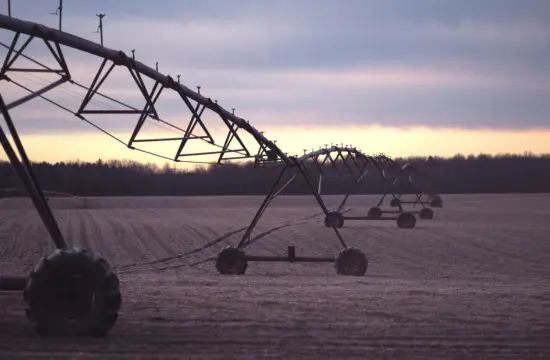Fertigation is the timely application of fertilizer through an irrigation system. It serves as an excellent nutrient delivery system to crops when they need it the most, such as times of rapid nutrient uptake. It also allows farmers the flexibility to incorporate fungicides and insecticides along with nutrients.
Q: What benefits does fertigation provide to growers?
JP: Fertigation provides farmers extra flexibility in their purchasing decisions and nutrient management programs. They may decide to purchase nitrogen (N) early, or delay it, based on fertilizer prices and their application schedule. Farmers can give their crops an extra boost by increasing their fertilizer program late in the season. If they think there’s enough N in the correct place, but crops don’t look as good a week later, they can give it an extra boost of fertilizer to help out.
Q: What types of irrigation equipment are best suited for fertigation?
JP: The two most common and preferred fertigation methods are through an underground drip system or center pivot irrigation. Farmers only need a piston pump to help inject the fertilizer into the system.
Q: When is the best time to use fertigation on crops?
JP: Every crop and every field is different and it depends on the individual nutrient management plan. Some farmers will start early with smaller applications and make six to eight applications throughout the growing season. Others will put down the majority of their N and follow up later with the rest via fertigation.
Q: What crops see good results from fertigation?
JP: Fertigation is a common practice on specialty crops, but row crops benefit as well. There are several different blends of fertilizers and multiple applications making fertigation an easy system to incorporate. Also, specialty crops normally have a greater water requirement than row crops. In row crops, corn is the most popular crop for fertigation.
Q: Are there specific geographies where fertigation is more beneficial than others? Is it preferable in more arid areas of the country?
JP: Like in all ag practices, geography plays a vital role in the decision-making process. Fertigation is more preferable in dry regions because there’s less moisture and, often times, sandier soils. It’s more advantageous in course soils that don’t hold moisture or N for long periods of time.
Q: Are there any watch-outs or cautions when fertigating?
JP: The main caution is to keep Mother Nature in mind. If it’s too muddy, pivots can’t run and then farmers risk not having a delivery system for fertilizer and a starving crop. It’s better to start earlier in the season in case it rains and they have to shut off the pivot, especially if that’s their main fertilizer supply.
Q: How much money does a grower save by applying crop protection products and fertilizers via irrigation, versus making an application trip?
JP: In most cases, one application trip can cost anywhere from $5-$10 per acre, depending on the sprayer. Putting it in irrigation doesn’t cost very much because water’s already being put down. Fertigation might only cost an extra 25-50 cents for one application. Those are estimates, but fertigation can be an inexpensive way to apply nutrients.
Q: Are there times when fertigation is best to avoid possible mechanical damage to a crop from running a spray rig?
JP: Any time a crop matures, there’s a chance for running down a percentage of the crop. Whether it’s because of uneven rows, twin rows or the GPS is off a little, equipment might hit the crop. Also, the taller the corn gets, the greater risk for run-down. In center pivot fertigation, for example, the pivot only runs in one line each time. It’s always running the same pass, so there’s no extra damage. Due to its height, there’s less chance of hitting the top of the corn crop.
Q: What is the difference between fertigation and chemigation?
JP: Sometimes the terms are used interchangeably, but there is a distinction. Fertigation is the application of fertilizer only. Chemigation is the application of chemicals such as fungicides and pesticides.
Q: What impact, if any, does drought such as in California or dropping water tables (i.e. the need to reduce water usage) have on fertigation and its desirability?
JP: Areas affected by drought or water restrictions may prefer fertigation because they can better manage the nutrients and the water supply. They can apply the fertilizers according to the water that’s available.
For farmers who already use an irrigation system to deliver water to their crops, adding a fertilizer such as nitrogen through fertigation may be an efficient way to deliver nutrients as well.


